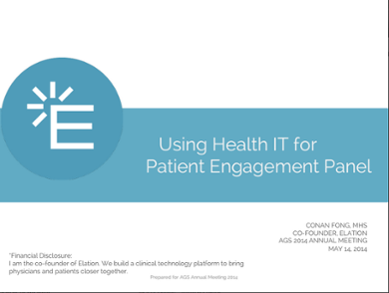Highlights and Insights From the American Geriatrics Society Annual Meeting

Highlights and Insights From the American Geriatrics Society Annual Meeting May 27, 2014
 Click the above image to view Conan Fong’s full presentation from his panel discussion at the annual meeting of the American Geriatrics Society.
Click the above image to view Conan Fong’s full presentation from his panel discussion at the annual meeting of the American Geriatrics Society.
Earlier this month, Elation co-founder Conan Fong traveled to the annual meeting of the American Geriatrics Society and presented as part of a panel on using health IT to improve patient engagement. Other panelists included Dr. Peter Tang, Dr. Michael Gloth III, Dr. Susan Fields, Dr. Joshua Chodosh and Dr. Michael Malone. It was a thoughtful and engaging discussion about how doctors and healthcare organizations are customizing health IT tools to meet the needs of great geriatrics care. Check out Conan’s full presentation, or read on for the nutshell version.
Conan’s core messages:
– Patient engagement is actually a reflection of the strength of the patient-provider relationship.
– The key to increasing patient engagement is getting providers engaged on these platforms.
– Strong patient engagement is available today without spending millions.
What’s the patient-engagement problem?
– Patient engagement is still relatively low despite patients’ desire to be more actively involved in their care.
Why is this happening?
– Information is not consistently available to the patient.
– Information is not clear.
– Patients are unsure of the value – how does this complement the care they’ve received from their provider?
And what’s the solution?
– Make it as easy as possible for providers to access and act upon information in a clinical context. (Here’s how Elation does just that.)
Doctors are already using health IT as part of their care delivery, but it’s incumbent on us as vendors and product developers to make it as seamless and intuitive as possible. Only then will providers be fully engaged and comfortable with their technological tools — and ready to use them with patients.
What do you do to involve patients in their care? Share your tips in the comments. We’d love to hear from you!






